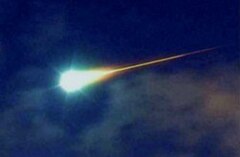A bolide is normally taken to mean an exceptionally bright meteor, but the term is subject to more than one definition, according to context. It may refer to any large crater-forming body, or to one that explodes in the atmosphere. It can be a synonym for a fireball, sometimes specific to those with an apparent magnitude of −14 or brighter.
Definitions edit
The word bolide (/ˈboʊlaɪd/; from Italian via Latin, from Ancient Greek βολίς (bolís) 'missile'[2][3]) may refer to somewhat different phenomena depending on the context in which the word appears, and readers may need to make inferences to determine which meaning is intended in a particular publication.
One sense refers to an extremely bright meteor, especially one that explodes in the atmosphere. In astronomy, it refers to a fireball about as bright as the full moon, and it is generally considered a synonym for a fireball. In geology, a bolide is a very large impactor.
One definition describes a bolide as a fireball reaching an apparent magnitude of −14 or brighter – more than twice as bright as the full moon.[4] Another definition describes a bolide as any generic large crater-forming impacting body whose composition (for example, whether it is a rocky or metallic asteroid, or an icy comet) is unknown.[5]
A superbolide is a bolide that reaches an apparent magnitude of −17 or brighter,[4][6] which is roughly 100 times brighter than the full moon. Recent examples of superbolides include the Sutter's Mill meteorite in California and the Chelyabinsk meteor in Russia.
Astronomy edit
The IAU has no official definition of "bolide", and generally considers the term synonymous with fireball, a brighter-than-usual meteor; however, the term generally applies to fireballs reaching an apparent magnitude −14 or brighter.[4] Astronomers tend to use bolide to identify an exceptionally bright fireball, particularly one that explodes (sometimes called a detonating fireball).[7] It may also be used to mean a fireball that is audible.
Superbolide edit
Selected superbolide air bursts:
- Tunguska event (Russia, 1908)
- 2009 Sulawesi superbolide (Indonesia, 2009)
- Chelyabinsk meteor (Russia, 2013)
Geology edit
Geologists use the term bolide differently from astronomers. In geology, it indicates a very large impactor. For example, the Woods Hole Coastal and Marine Science Center of the USGS uses bolide for any large crater-forming impacting body whose origin and composition is unknown, as, for example, whether it was a stony or metallic asteroid, or a less dense, icy comet made of volatiles, such as water, ammonia, and methane.[5]
The most notable example is the bolide that caused the Chicxulub crater 66 million years ago. Scientific consensus agrees that this event directly led to the extinction of all non-avian dinosaurs, and it is evidenced by a thin layer of iridium found at that geological layer marking the K–Pg boundary.
Gallery edit
See also edit
References edit
- ^ "We are not Alone: Government Sensors Shed New Light on Asteroid Hazards". Universe Today. Retrieved 12 April 2015.
- ^ "bolide". Merriam-Webster.com Dictionary.
- ^ "bolide". Oxford English Dictionary (Online ed.). Oxford University Press. (Subscription or participating institution membership required.)
- ^ a b c Belton, MJS (2004). Mitigation of hazardous comets and asteroids. Cambridge University Press. ISBN 0521827647.: 156
- ^ a b "Introduction: What is a Bolide?". Woodshole.er.usgs.gov. 1 April 1998. Retrieved 16 September 2011.
- ^ Adushkin, Vitaly; Ivan Nemchinov (2008). Catastrophic events caused by cosmic objects. Springer. ISBN 978-1402064524.: 133
- ^ bolide. Oxford University Press. 2018. ISBN 978-0191851193. Retrieved 1 September 2019.
{{cite book}}:|work=ignored (help)
External links edit
- historic record of bolides that have been witnessed entering the Earth’s atmosphere around the world from 861 through 2012 (B612 Foundation)
- Bolide Events from 1988 to the present neo.jpl.nasa.gov
- Earth Impact Effects Program Estimates crater size and other effects of a specified body colliding with Earth.

